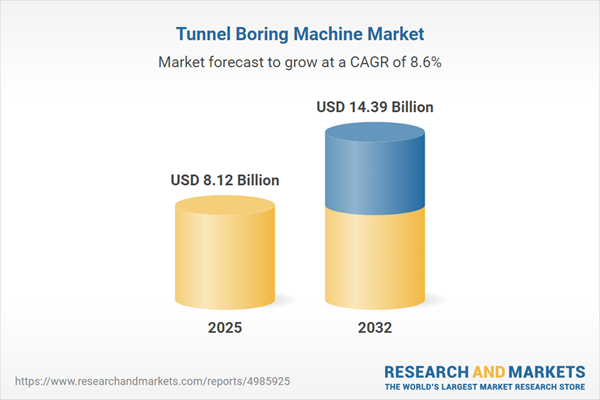Speak directly to the analyst to clarify any post sales queries you may have.
The tunnel boring machine market is redefining how infrastructure leaders plan and deliver the next generation of underground construction. Senior decision-makers are adopting advanced TBM solutions to improve operational safety, minimize project risk, and align with stricter regulatory and lifecycle demands for large-scale transit and utility projects.
Market Snapshot: Tunnel Boring Machine Market Growth
The global tunnel boring machine market is witnessing significant expansion, with the sector valued at USD 7.46 billion in 2024 and projected to reach USD 8.12 billion in 2025. By 2032, it is forecast to attain USD 14.39 billion, supported by a CAGR of 8.55%.
Key drivers behind this growth include increasing investment in urban mobility, the expansion of hydropower infrastructure, and the construction of major underground utility corridors. Competitive landscape evolution is characterized by organizations differentiating through regional specialization, responsive procurement approaches, and technology advancements shaping supplier and client priorities across diverse markets.Scope & Segmentation of the Tunnel Boring Machine Market
This report presents a detailed segmentation of the tunnel boring machine market, offering senior executives actionable intelligence for optimizing capital allocation and strategic initiatives. Market segments are as follows:
- TBM Types: Double Shield, Earth Pressure Balance (utilized for adaptable performance in hard and soft ground conditions), Open TBM, Single Shield, Slurry Shield (including Bentonite and Sand Slurry solutions).
- Applications: Hydropower, Metro, Railway, Roadway, and Utility projects, each with tailored TBM technology requirements informed by unique geological and delivery needs.
- Diameter Ranges: Options include below 4 meters, 4–6 meters, 6–9 meters, and above 9 meters, enabling right-sizing for project-specific throughput and construction scale.
- End Users: Construction Companies, Government Agencies, and Private Developers, highlighting ongoing shifts in procurement, partnership, and risk-sharing models.
- Geographies:
- Americas, covering North America (United States, Canada, Mexico) and Latin America (Brazil, Argentina, Chile, Colombia, Peru).
- Europe, Middle East, and Africa, including United Kingdom, Germany, France, Russia, Italy, Spain, Netherlands, Sweden, Poland, Switzerland, United Arab Emirates, Saudi Arabia, Qatar, Turkey, Israel, South Africa, Nigeria, Egypt, Kenya.
- Asia-Pacific, featuring China, India, Japan, Australia, South Korea, Indonesia, Thailand, Malaysia, Singapore, Taiwan.
- Key Companies: Focus includes Herrenknecht AG, China Railway Construction Heavy Industry Co., Ltd., The Robbins Company, Mitsubishi Heavy Industries, Ltd., TERRATEC Pty Ltd, Komatsu Ltd., China Railway Engineering Equipment Group Co., Ltd., Lovat S.p.A., Hitachi Zosen Corporation, and SELI Overseas S.p.A., each bringing distinct capabilities and regional strengths to the sector.
Key Takeaways for Senior Decision-Makers
- The adoption of digital twins and real-time monitoring is increasing, allowing asset managers to enhance visibility, optimize maintenance scheduling, and reduce construction risks for complex underground projects.
- Leading organizations are focusing on automation, predictive maintenance technologies, and remote diagnostics to streamline asset management and efficiently meet project performance targets.
- Specification divergence is evident across regions; for example, projects in North America frequently require advanced environmental management, while those in Asia-Pacific focus on high-output, automated tunneling systems for large volumes.
- Manufacturers are forging local production partnerships to address supply chain stability, fulfill regulatory requirements, and benefit from offset incentives in both mature and developing markets.
- Procurement preferences are shifting as private entities increasingly seek integrated, turnkey TBM packages that encompass equipment supply and lifecycle services, emphasizing accountability and cost predictability.
- Strategic collaboration among OEMs, software providers, and component suppliers is driving accelerated technology integration and agile responses to changing market conditions.
Tariff Impact and Strategic Response
Recent tariff policy adjustments in the United States have prompted modifications in TBM sourcing and assembly strategies. Stakeholders are now focusing on expanding domestic manufacturing, implementing scenario-based contracting, and conducting thorough risk assessments. These changes are intended to control costs and reinforce local supplier capabilities amid continued global trade uncertainty.
Methodology & Data Sources
This analysis is based on structured interviews with senior executives from TBM manufacturers and infrastructure organizations, supported by technical journal reviews, project database analysis, and regulatory filings. Industry-standard methodologies, including Porter’s Five Forces, PESTEL, and data triangulation, underpin the reliability and relevance of these insights.
Why This Report Matters for Industry Leaders
- Enables informed decision-making by identifying technology and regulatory shifts that impact the tunnel boring machine industry and future project strategies.
- Provides benchmarks for supply chain resilience, digital systems integration, and asset lifecycle management to guide risk reduction and operational continuity.
- Supports the prioritization of high-opportunity geographic regions and market segments, helping leaders allocate resources where project execution risk is lowest.
Conclusion
The tunnel boring machine market is adapting to new technology, policy shifts, and rising expectations in end-user requirements. Executives who utilize these insights will strengthen project outcomes and establish sustainable competitiveness within this evolving landscape.
Additional Product Information:
- Purchase of this report includes 1 year online access with quarterly updates.
- This report can be updated on request. Please contact our Customer Experience team using the Ask a Question widget on our website.
Table of Contents
3. Executive Summary
4. Market Overview
7. Cumulative Impact of Artificial Intelligence 2025
List of Figures
Samples

LOADING...
Companies Mentioned
The key companies profiled in this Tunnel Boring Machine market report include:- Herrenknecht AG
- China Railway Construction Heavy Industry Co., Ltd.
- The Robbins Company
- Mitsubishi Heavy Industries, Ltd.
- TERRATEC Pty Ltd
- Komatsu Ltd.
- China Railway Engineering Equipment Group Co., Ltd.
- Lovat S.p.A.
- Hitachi Zosen Corporation
- SELI Overseas S.p.A.
Table Information
| Report Attribute | Details |
|---|---|
| No. of Pages | 194 |
| Published | October 2025 |
| Forecast Period | 2025 - 2032 |
| Estimated Market Value ( USD | $ 8.12 Billion |
| Forecasted Market Value ( USD | $ 14.39 Billion |
| Compound Annual Growth Rate | 8.5% |
| Regions Covered | Global |
| No. of Companies Mentioned | 11 |









